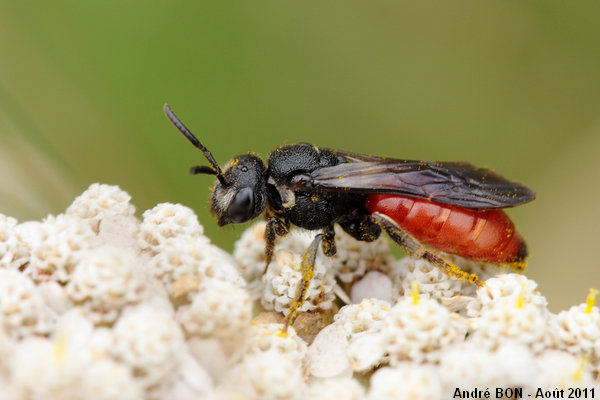
| Sphecodes albilabris (Fabricius, 1793) |

|
|
Scientific name: Sphecodes albilabris (Fabricius, 1793) Common name: French name: Sphécode à labre blanc Order: Hymenoptera Family: Halictidae Wingspan : 11-15 mm. Biotope: Open and sandy places. Geographic area: Western Europe north to southern Sweden and southern Finland, missing in the British Isles. Central Europe. Observation period : March to May for females which have overwintered. July to September for the new generation. |
Sphecodes albilabris is a solitary bee. It shows a black head and a black thorax. The abdomen is red except the tip which is black. Only the last segment is totally black. The abdomen reaches its largest section near sternites 3-4. There is a strong white pilosity on the face under the frons. There are also white hairs on the legs and on the tegulae, that's to say at the base of the wings where you can distinguish like a white patch. The wings are dark. They show a S-curved basal vein and three cubital cells typical on bees of the Halictidae family. The antennae have 12 articles on females and 13 on males. Males' antennae are longer and narrowed between articles. The scapus is shorter. The scutum, on the upper side of the thorax is strongly punctate. The punctures are very tight and larger than the interspaces. The abdomen is also completely but more finely punctate. Sphecodes albilabris is cuckoo bee which parasites Colletes cunicularius. Females enter the nest, eat or kill the eggs which are in the cells and replace them with their own eggs. The larvae grow by feeding on the stock of pollen and honey stored by Colletes cunicularius. The Sphecodes genus includes 33 species in Europe. The body size is the first criteria to take into account. Sphecodes albilabris is the largest species. Only 11 other species can reach or exceed a body size of 10 mm. I have tried to search into documents (for females only - body size of at least 10 mm) the visual criteria allowing to confirm the Sphecodes albilabris species (to consider with some reserves as this is only the result of researches among documents and not the result of some experience in the fields). I have found many pictures showing specimens with a larger black area on the abdomen tip than on Sphecodes albilabris. I have only found confirmation of this fact in documents for Sphecodes pellucidus and Sphecodes rubicundus with a larger black area on the upper side than on the lateral sides for this last one. Sphecodes olivieri shows a reddish thorax, it is black on Sphecodes albilabris. Sphecodes scabricollis and Sphecodes spinulosus show a ridge at the back of the head. This ridge is better marked on Sphecodes spinulosus. The back of the head is a rounded shape on Sphecodes albilabris. The scutum of Sphecodes gibbus is very lightly punctate, the one of Sphecodes schenckii shows less punctures on the edges. The interspaces of punctures on the scutum of Sphecodes reticulatus, Sphecodes alternatus and Sphecodes crassanus are larger than the punctures themselves, unlike on Sphecodes albilabris. Sphecodes monilicornis has a square-shaped head with large cheeks at the back of the eyes. |
| [To know more about the Sphecodes albilabris] [Top] |

|
You cannot exactly evaluate the body size of this bee with this picture but I remember one insect of at least 10 mm. The antennae are not narrowed between articles and so indicate one female. The small black area at the abdomen tip and the strong and tight punctures on the scutum make me decide for the Sphecodes albilabris species. |